Making SA footy’s King a Legend
Neil Kerley is an undisputed legend of South Australian football, so Michelangelo Rucci asks: Why isn’t he recognised as such by the Australian Football Hall of Fame?
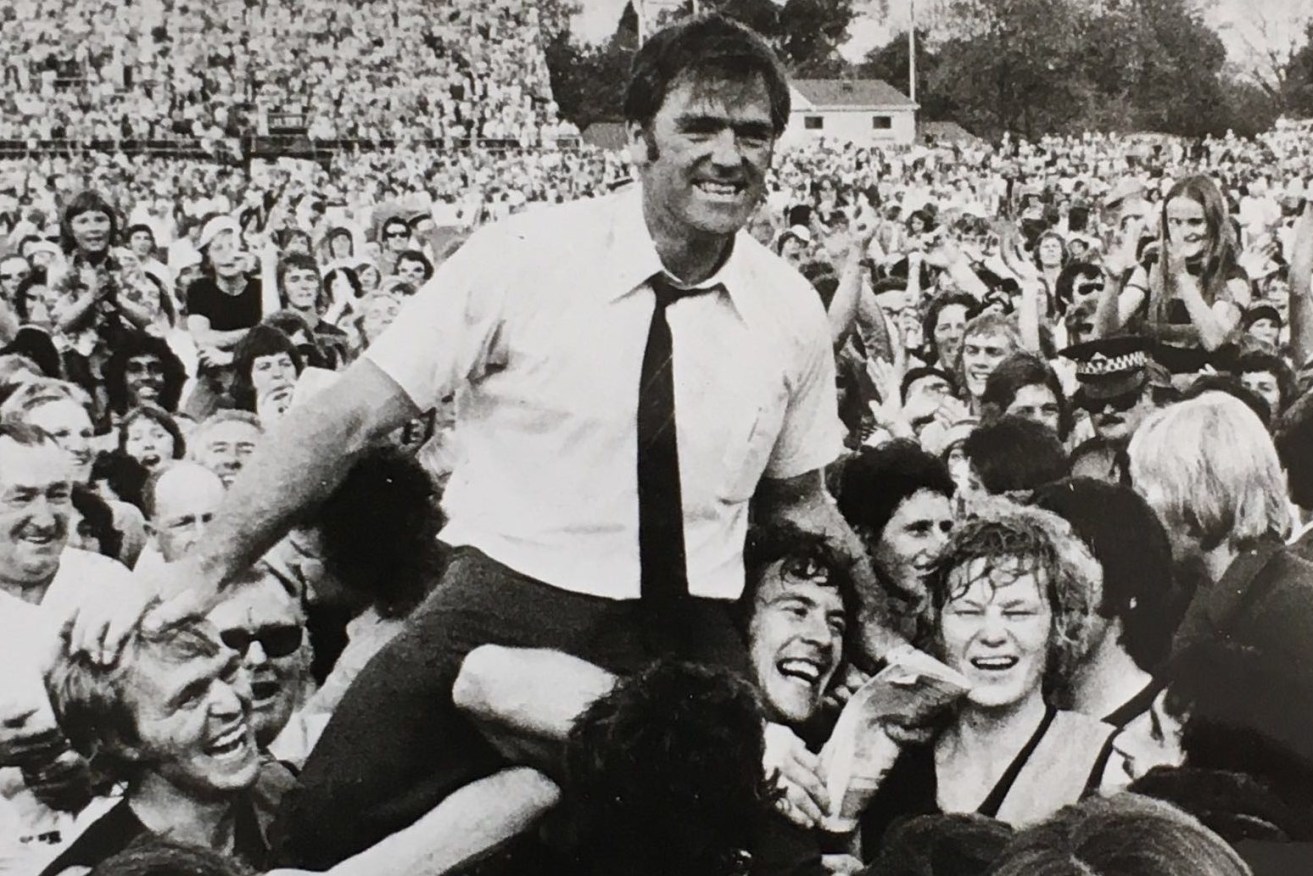
Neil Kerley is chaired from the ground after coaching Glenelg to its drought-breaking 1973 Grand Final win against North Adelaide. Photo: SANFL
Neil Kerley always will be a “legend”. That is, a legend as defined in the dictionary: “An extremely famous or notorious person, especially in a particular field.”
“Neil Kerley, absolutely, is a legend,” says former AFL chief executive Wayne Jackson, who last week delivered one of the eulogies at the king of SA football’s state funeral at Adelaide Oval.
“He is a legend because he is someone who has his on-field performances speak for themselves.
“He is someone who made a difference in the game. He is someone who has made a significant contribution to the game off the field. And Neil passes the pub test (as a ‘legend’).”
So why – as many people have asked since Kerley’s death on June 29 at the age of 88 – is Kerley not a “Legend” in the Australian Football Hall of Fame?
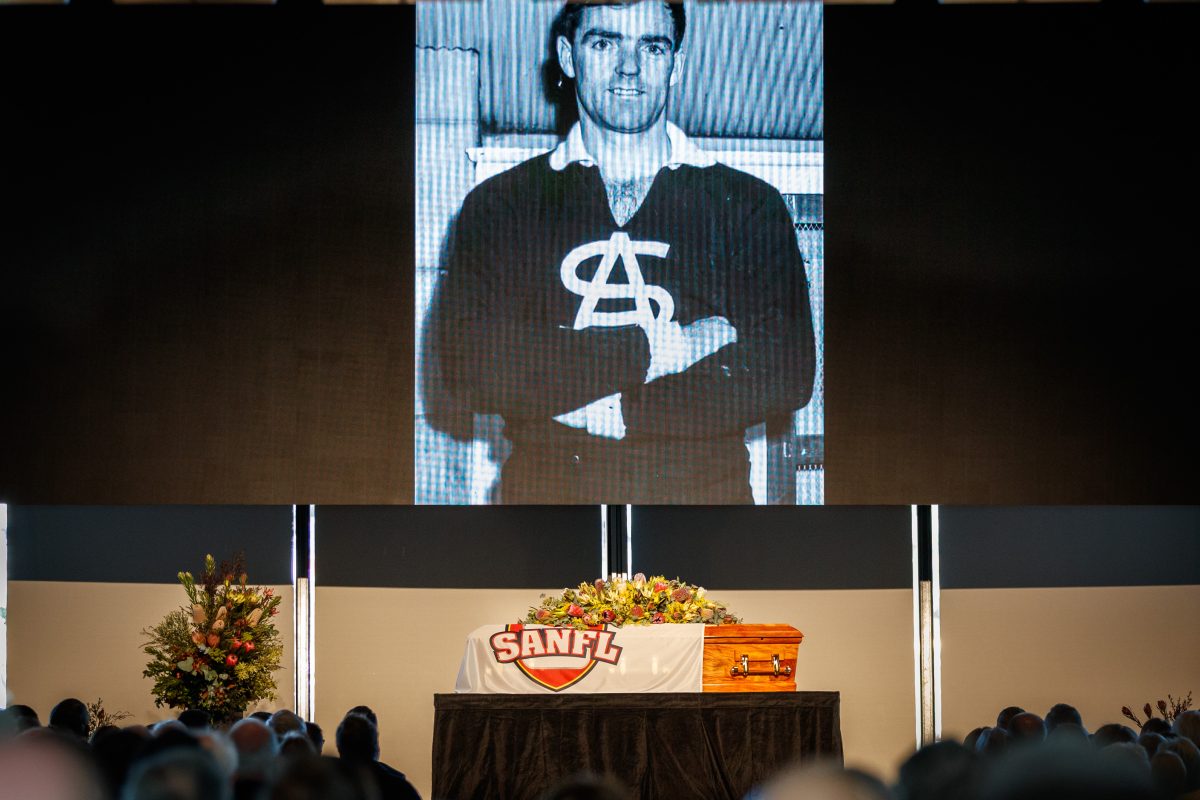
Neil Kerley was given the honour of being farewelled at a state funeral at Adelaide Oval. Photo: AAP/Matt Turner
The question also applies to other South Australian football legends such as Ken Farmer, Fos Williams, Tom MacKenzie, Bob Quinn …
And it is more intriguing when a Victorian – a man who has made his name thwarting or agitating South Australian football interests – is today leading the public campaign to have Kerley elevated to a higher pedestal in Australian football’s pantheon of greats.
Eddie McGuire, the former Collingwood president who created an image niggling South Australians in one of the fiercest divides in Australian football, used Kerley’s funeral to remind current AFL chief executive Gillon McLachlan of the “legends” being left behind in the cluttered queue to become “Legends” in the Hall of Fame.
“The AFL,” says McGuire, “sometimes has the romance and feel of the Australian Taxation Office.”
“The AFL – and not for the first time – missed the opportunity while Neil was alive to recognise ‘Knuckles’ for what he was and will remain – a legend of the game.”
Legends don’t fit onto spreadsheets. They are unscripted. They are original. When you meet them for the first time, you feel a force of nature. That was Neil Kerley
McGuire thinks Kerley denied himself “Legend” status “because when he was on the selection committee, he was busy pushing up his Croweater mates”.
Kerley was an All-Australian selector who fiercely promoted the cases of Crows and Port Adelaide players, to the point McGuire remembers the “drinking game” at All-Australian dinners was to spot the South Australian “sponsored by Kerls”. But he was never a selector for the national Hall of Fame.
From South Australia today, that task – or duty – sits with one of Kerley’s grandest disciples, Graham Cornes.
“I have asked Graham,” says McGuire of Kerley’s merit to be a “Legend”.
“He told me ‘Kerls’ doesn’t quite fit the criteria for ‘Legend’ status. It is a bit like (Collingwood great) Lou Richards,” added McGuire who has spent decades arguing for Richards, one of his mentors in television, to be elevated to the “Legend” pedestals in the national Hall of Fame.
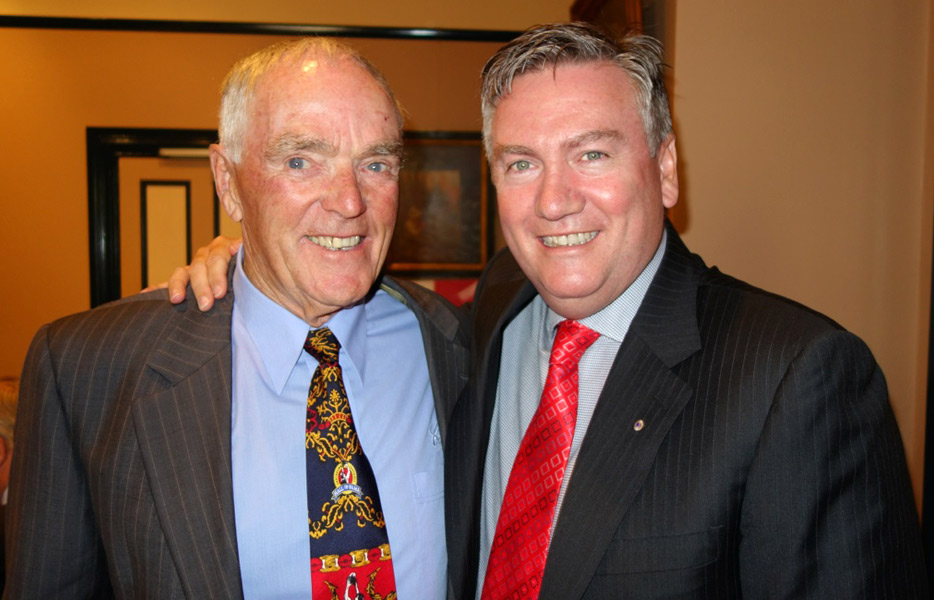
Neil Kerley and Eddie McGuire. Photo supplied
“Legends don’t fit onto spreadsheets (detailing a player or coach’s record of games won and awards achieved). They are unscripted. They are original. When you meet them for the first time, you feel a force of nature. That was Neil Kerley.
“Neil is a legend in name – and deed.”
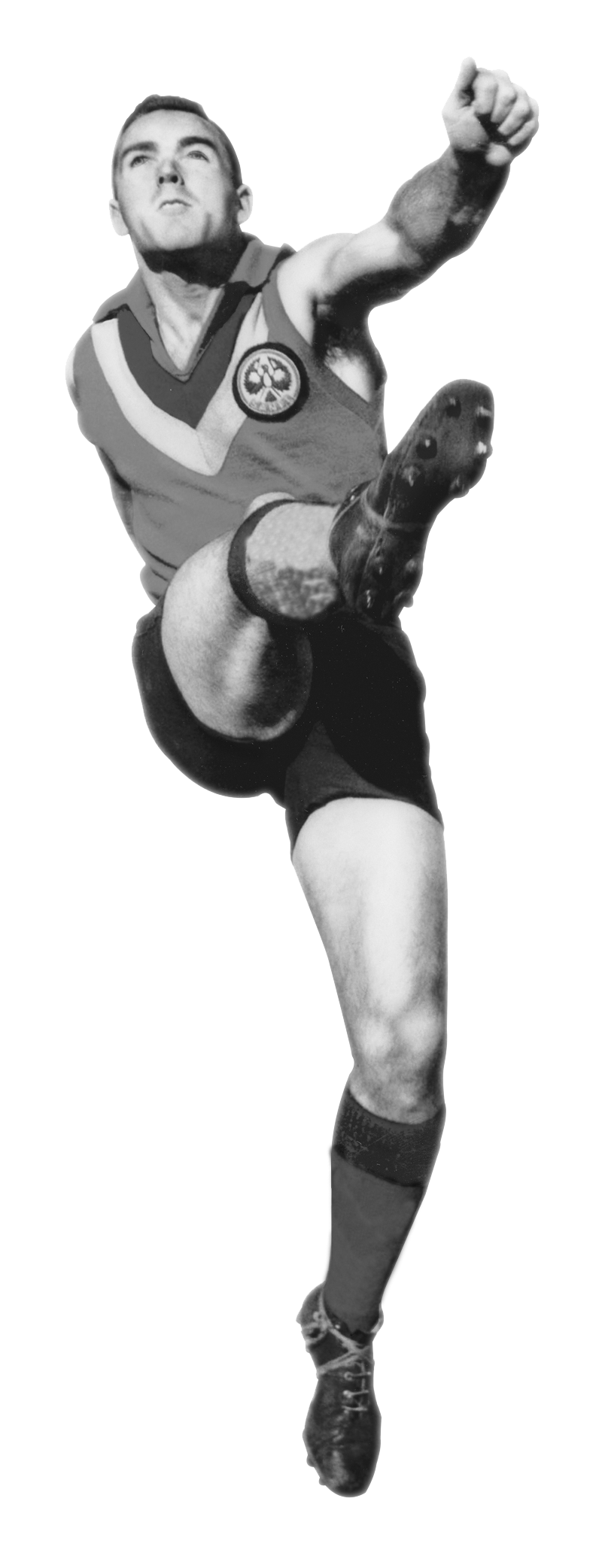
Photo: SANFL
The Australian Football Hall of Fame charter defines a “Legend” as a player or coach who has “had a particularly significant positive impact on the game of Australian football”. Some might pose the question, if the Hall of Fame is the grandest pantheon in Australian football why does it need another level of greatness with “Legend” status?
As AFL chief executive from 1996-2004, Jackson chaired the Australian Football Hall of Fame selection meetings. Earlier, Jackson was a member of the AFL Commission that needed to ratify the recommendations made by the Hall of Fame’s selection panel.
While he quickly and enthusiastically acknowledged in his interview with InDaily this week that Kerley is a “legend”, he was more circumspect when recalling how a “Legend” is crowned in the Hall of Fame.
“I leave that call to the discretion of the selection committee,” said a diplomatic Jackson. “There is a whole list of people considered, and they have to fit certain parameters.
“As (former AFL Commission chairman) Ron Evans said at one Hall of Fame induction ceremony, you have to wait your turn. And if you belong, you make it to the Hall of Fame and you also rise to ‘Legend” status if you deserve that honour.
“I chaired those meetings for a long time. There are many names put forward. But you have to fit the parameters detailed in the charter. Neil would have to be in the mix. He would be considered.”
Ted Whitten was the first “Legend” in the Australian Football Hall of Fame. The Victorian legend was inducted while in ill health with cancer, before the formal start to the Hall of Fame in the VFL-AFL’s centenary season of 1996.
Kerley was among the first 136 inductees for the national Hall of Fame in 1996. Whitten and Kerley have long been considered mirror images separated by the Victorian-South Australian border. If Whitten is officially known as a “Legend” in the national Hall of Fame, surely Kerley – his “brother in football,” as McGuire put it – should hold the same status.
Their records make for a telling comparison.
Whitten played 321 VFL senior games – all at Footscray – from 1951-1970. Kerley played 265 SANFL senior matches – at three clubs, West Adelaide, South Adelaide and Glenelg – from 1952-1969.
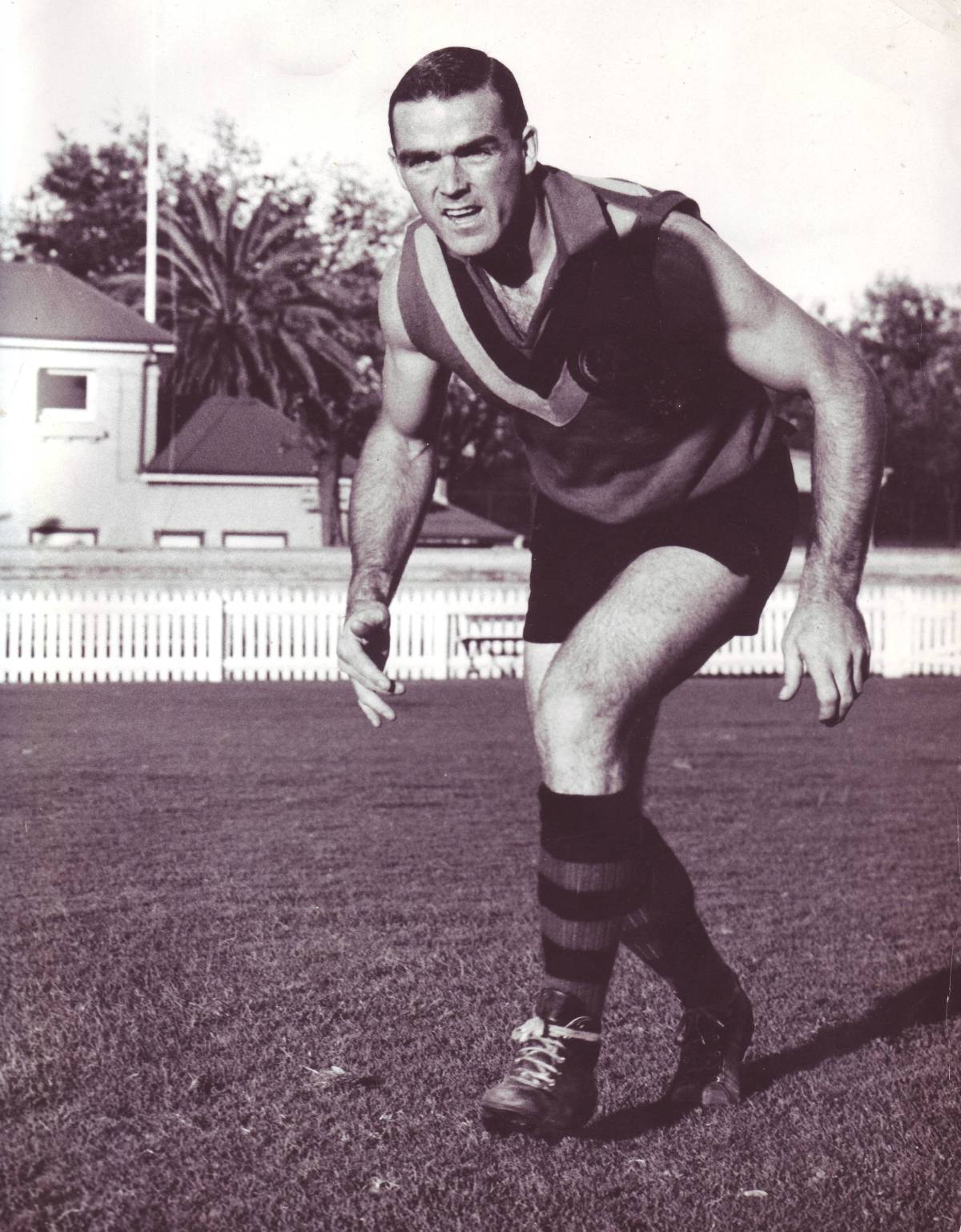
Photo: SANFL
Whitten had five best-and-fairest titles. Kerley also had five – four at West Adelaide and one at Glenelg. Whitten represented Victoria 29 times, Kerley wore the South Australian State jumper 32 times and was captain six times. Both achieved All-Australian honours; Whitten, four times, Kerley once in 1961 as vice-captain.
Whitten coached Footscray in 228 games from 1957-1971 without premiership success. Kerley coached five SANFL clubs – West Adelaide, South Adelaide, Glenelg, West Torrens and Central District – in 628 games from 1961-1990, with flags at West Adelaide (twice), Glenelg (the drought-breaker of 1973) and South Adelaide with the rise from wooden spoon to premiership in 1964.
Whitten does not have a Brownlow Medal. Kerley did not win the Magarey Medal.
Even by the more subjective theme posed by the Hall of Fame charter – deciding if a “Legend” candidate has had a “particularly significant positive impact on the game” – there is nothing, or very little, that splits Whitten and Kerley.
Ross Oakley is the “father” of the Australian Football Hall of Fame.
“The concept,” Oakley told InDaily from his Queensland retreat, “came while I (as AFL chief executive) was in the United States for a Super Bowl. There was the opportunity to see the Baseball Hall of Fame at Cooperstown (in New York State).
“From the moment you walk into the museum there is an extraordinary atmosphere that you feel you have to keep quiet. It is a revered place. I felt it was something we had to have for Australian football. So, we put it all together for the league’s centenary season in 1996.
“We wanted to recognise the achievements of all the great players in all of Australian football – all of Australian football. It never was to be the ‘AFL Hall of Fame’, it was to be the Australian Football Hall of Fame.
The AFL sometimes has the romance and feel of the Australian Taxation Office
“Life membership did not do it. Brownlow Medals did not do it, particularly when so many of the game’s greatest players – Graham ‘Polly’ Farmer, Ron Barassi, Ted Whitten, Darel Baldock – had not won the Brownlow.
“We had not recognised the game’s greats adequately. And this – the Hall of Fame – was the way to do it.”
But why the higher pedestals with “Legends” status?
“We felt absolutely outstanding players should be recognised as ‘Legends’,” Oakley said. “The best of the best. Other Halls of Fame use more than one category to honour their greats. ‘Legends’ are the cream of the crop. They are the players who have changed the game for the good. They are seen as players who changed the way the game was played.
“The original concept was to recognise ‘Legends’ as players who had contributed on the field. This ruled out administrators, umpires, coaches and the media (who could earn Hall of Fame induction).
“It was then put to me (with Essendon master coach Kevin Sheedy as the main example) that coaches also contribute to what happens on the field. I could not argue against that, so coaches are now able to be elevated to ‘Legend’ status.”
McGuire has challenged this restrictive qualification for “Legend” status in the national Hall of Fame with a long-running campaign to put Richards on the highest pedestal. So far, the AFL Commission has answered with induction to the Hall of Fame in 2004 and a decade later with the John Kennedy Lifetime Achievement Award, in recognition of his contribution to Australian football beyond the 250 VFL games he played for Collingwood during the 1940s and 1950s.
“What is Lou Richards famous for?” says Oakley in response to the question of Richards’ claim to “Legend” status in the national Hall of Fame.
The answer is in how then AFL Commission chairman Mike Fitzpatrick acknowledged Richards when handing him the league’s lifetime achievement award: “Working across radio, television and print, Lou became a larger-than-life character who helped to bring football to life for millions of fans in their lounge rooms throughout an extraordinary post-playing career involved with the game.”
“There is a media Hall of Fame,” says Oakley. “I have had this discussion with Eddie McGuire. Media personalities do not become ‘Legends’ in the Hall of Fame. Lou Richards is certainly a media legend. And there is another hall of fame for that.”
In Victoria, Neil Kerley is known as the archetypal South Australian. He also is regarded as a legend
South Australian football has four “Legends” in the national Hall of Fame.
The first in 2001 was three-time Magarey Medallist Barrie Robran, regarded as the greatest South Australian player of all time.
Next in 2017 was Malcolm Blight, who left his unforgettable mark on the game both in South Australia and Victoria.
Then the Hall in 2021 recognised Jack Oatey, the 10-time SANFL premiership coach with the most wins – across a 38-year, 786-game coaching stint – at all levels of senior Australian football.
And this year the Hall elevated four-time Magarey Medallist Russell Ebert.
The list of “legends-in-waiting” from the SANFL is long and continues to have new candidates from the AFL era.
North Adelaide goalkicking great Ken Farmer, one of the four footballers honoured with statues at Adelaide Oval along with Robran, Ebert and Blight, was remarkably left out of the inaugural inductions to the Australian Football Hall of Fame in 1996. This is despite his phenomenal goalkicking record that has stood unchallenged for eight decades – 1417 goals scored from 1929-1941.
Officially, the SANFL has endorsed Farmer, Sturt great and triple Magarey Medallist Len Fitzgerald and nine-time premiership coach Fos Williams.
Externally, there are noted football historians and well-researched observers of South Australian football such as author and ABC commentator James Coventry, who question why the Australian Football Hall of Fame has a supposed “blind spot” to the early greats of Australian football.
When Sheedy was elevated to “Legend” status in 2018, Coventry noted: “You have to think something’s gone seriously wrong with past selection for the Hall of Fame to now be in a position where 17 of its 28 ‘Legends’ were active in 1969.”
The same can be said of the “new” Adelaide Oval, where the so-called “inventory” of grandstands, statues, bars and terraces recognises only South Australian footballers since the 1930s, starting with the Bob Quinn gates at the northern end. The heroes of the first 60 years of the oldest State league – including the only man to win three consecutive Magarey Medals during the 1920s, South Adelaide defender Dan Moriarty – do not have their names cast in bronze at the Oval.
Kerley is remembered with his name at the members’ bar in the Riverbank grandstand at the southern end. The push to have a statue goes on.
The campaign to have the “King” become a “Legend” in the Australian Football Hall of Fame gets new impetus with McGuire’s endorsement. And the footnote that a Victorian could lift Kerley to the “Legend” pedestal would probably bring that unforgettable laugh – rather the memorable growl – from a man who spent his football life fighting the “Big V”.
“In Victoria,” says McGuire, “Neil Kerley is known as the archetypal South Australian. He also is regarded as a legend.”
Michelangelo Rucci was an Australian Football Hall of Fame selector for nine years. He remains on the SA Football Hall of Fame selection panel.




